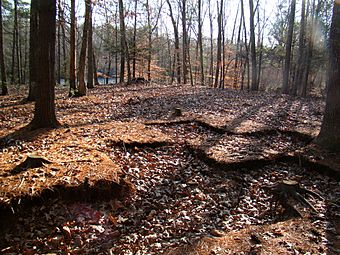Quinebaug River Prehistoric Archeological District facts for kids
Quick facts for kids |
|
|
Quinebaug River Prehistoric Archeological District
|
|

2009 dig of Native American fishing village conducted by State Archeologist and UCONN
|
|
| Location | Between CT 169 and the Quinebaug River Canterbury, Connecticut |
|---|---|
| Area | 22 acres (8.9 ha) |
| NRHP reference No. | 09000696 |
| Added to NRHP | September 7, 2009 |
The Quinebaug River Prehistoric Archeological District is a special area in Canterbury, Connecticut. It's where scientists have found many clues about people who lived there long, long ago. This district covers about 22 acres (or 9 hectares). It holds five important sites that show how people lived from about 6,000 years ago until Europeans arrived. This area became a protected state archaeological preserve in 2003. It was also added to the National Register of Historic Places in 2009.
Discovering Ancient Life
The Quinebaug River Prehistoric Archeological District is in eastern Canterbury. It sits on a raised area (called a terrace) that looks over the Quinebaug River. This land is owned by the state of Connecticut. It's located on the west side of the river, between a few roads like Connecticut Route 169.
During special surveys in 2001 and 2002, experts found five different sites here. These sites are important because they show signs of ancient homes and activities. The sites vary in size, from small spots of about 0.25 acres to larger areas of 6.4 acres. Most of the stone tools and other items found here are from a time called the Woodland Period.
Clues from the Past
Scientists found many more items from the Woodland Period at these sites. This suggests that more people lived there during that time, and maybe they stayed for longer periods. The layers of soil (called stratigraphy) show that the area might have flooded less often back then. This would have made it a better place to live.
However, there isn't much proof that people were farming a lot or staying in one place all the time during the later part of the Woodland Period. What's really interesting are the stone tools found here. Some of these stones came from quarries (places where stone is dug up) that are quite far away. This tells us that the ancient people living by the Quinebaug River traded with other groups from distant places.



